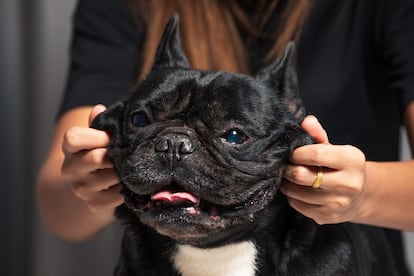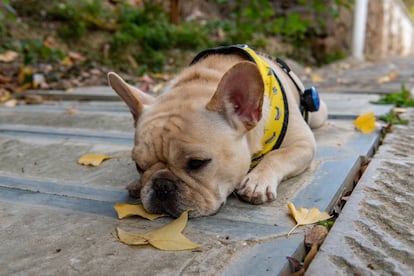Doggy capitalism: How the French bulldog’s popularity exposes the pet industry’s brutality
They’re popular, trendy and cute but have obvious health problems; the unnatural proliferation of these canines responds to the aesthetic demands of their consumers and questionable ethics

In June 2020, a Ukrainian International Airlines plane landed in Toronto. From the outside, it looked like a normal flight, but inside a hellish scene was unfolding: 500 French bulldog puppies were crying in their cages. Many were dehydrated, weak and panting. Thirty-eight of them were dead. The international media shone a spotlight on the illegal trafficking of this breed, which has skyrocketed to meet an incredible rise in demand. In the last decade, French bulldog registrations have increased by over 1,000% in the United States, according to the dog breed organization American Kennel Club (AKC). “There’s a new top dog in town!” the organization proclaimed in a press release last March. It was celebrating the fact that the French bulldog had become the most popular breed in the United States, unseating the Labrador after over 30 years of reigning supreme. But a dog breed’s popularity comes at a price.
Dogs have been commodified and are governed by the law of supply and demand. But unlike most consumer goods, there aren’t factories that can mass produce dogs. If customers want more puppies of a certain breed, the fastest way is to increase crossbreeding or bring in contraband. In addition to Ukraine, Latvia, Lithuania, Poland, Hungary, Serbia, Romania and Bulgaria serve as unscrupulous international breeders, according to a report on puppy smuggling by the NGO Dogs Trust.
The result is indiscriminate breeding. According to research at Imperial College London, the gene pool of the 10,000 registered pugs in the United Kingdom is so limited that it is the equivalent of about 50 dogs. Pedigree dogs are like Ancien Régime European monarchs: they are so inbred that they’ve begun to develop genetic defects, and with each generation, they get a little worse. The Netherlands has recognized this problem and banned issuing pedigrees for French bulldogs and pugs.
Brandi Hunter Munden, vice president of public relations and communication at the AKC, rejects that idea outright. “That’s inaccurate,” she explains in an email exchange with EL PAÍS. “Responsible breeders are not concerned about meeting demand based on popularity. They are focused on preserving the breed and breeding healthy dogs.” The AKC advocates prioritizing the dogs’ health and welfare, she says. For his part, Henry Mance, a Financial Times journalist and author of the book How to Love Animals in a Human-Shaped World, strongly disagrees. “It’s not about a few sick dogs but rather these breeds’ overall health,” he says in a telephone conversation. “To me it’s a shame that we continue to promote them as cute and trendy little dogs, and that the industry has not taken an ethical stand on this,” he explains. “French bulldogs and pugs are the clearest example that there is something wrong with this industry.”
Hunter Munden describes the French bulldog as a playful and irresistible dog. She says that “it has grown in popularity because of its versatility.” The organization’s website asserts that one of the Frenchie’s advantages is that they do not require much outdoor exercise. But the website does not explain that it’s because the snub-nosed dogs have serious breathing problems. In fact, it is difficult to take them out for a walk when temperatures are above 30 degrees Celsius (86 degrees Fahrenheit) without them getting exhausted. Another issue is that these dogs seem to pant between gasps instead of breathing. And most airlines have banned these dogs from flying after several of them died on flights (but not Ukrainian International Airlines).

As the French bulldog climbed up the list of the most popular dogs, its life expectancy decreased. According to a study by the Royal Veterinary College in Hatfield, United Kingdom, which investigated 30,000 dogs, it is the breed with the shortest longevity among 18 breeds analyzed, averaging just 4.5 years. The English bulldog, with an average life span of 7.4 years, is next on the list. These figures (which may be slightly distorted by the overrepresentation of puppies in these breeds) contrast with the nearly 13 years that the average Jack Russell lives. “French bulldogs are flat-faced and cute,” Dan O’Neill, the director of the study, told New Scientist magazine. “But the cost is that they live shorter lives and have trouble blinking and breathing all their lives.”
The problem goes beyond a particular group of dogs — the very idea that dogs can be classified into graded breeds is problematic. The study concluded that “the more a dog had been modified to suit human tastes, the shorter its overall life expectancy was.” For instance, in addition to bulldogs, the study reported that cocker spaniels have brains too large for their skulls and that boxers are increasingly prone to epilepsy. German shepherds suffer from hip and elbow dysplasia. When a dog becomes trendy, it condemns the breed genetically but is a windfall for breeders. The system is so perverse that philosophers like Gary Francione are against the mere existence of pets, based on the notion that the capitalist system has turned animals into property goods that can be speculated on.
The invention of the modern dog
The French bulldog is expensive: as such it serves as a status symbol. It is the celebrity dog of choice and the one that is most frequently mentioned on Instagram. Weighing about nine kilos (nearly 20 pounds) and perfectly sized for carry-on luggage, Frenchies are tiny and manageable. They appear in commercials and movies. These motives may seem frivolous, but they are not far removed from the reasons why Dalmatians (the Disney movie) and Border Collies (the Lassie series) became trendy. Now, to find out which dog is in fashion, one doesn’t have to go to the kennels; just take a look at television.
“We see these ads with purebred dogs and we want one just like it, but we don’t think about what that will mean for the dog itself or the whole breeding infrastructure behind it,” says Mance. “It’s a matter of ignorance.” According to Mance, we’ve established the perverse idea that we have the right to choose a dog with an aesthetic we like, “as if it were a handbag or a dress.”

But that idea has been entrenched for over a century. Although some dog varieties have their origins in earlier times, the classification of dogs into breeds and their detailed description started around 1860 in Victorian England. “That’s when the standards were set,” Mance explains. “The idea was that they had to look a certain way. Their health and behavior was not prioritized, just their esthetics. It was a form of eugenics.”
In the past, dogs were bred for a specific purpose. There were hunting dogs, herding dogs and companion dogs. Large, medium and small dogs. People spoke of dog types or variants, not breeds; their description was more vague, and their appearance could vary widely from one specimen to another. According to the authors of The Invention of the Modern Dog: Breed and Blood in Victorian Britain, that all changed with the advent of dog shows in the mid-19th century. Clubs such as the AKC were founded “to promote the sport of purebred dogs and breeding for functional purposes,” explains Hunter Munden. These organizations also began to classify and define the 200 breeds of dogs they recognize. “Each breed has a written standard, a set of characteristics about how the dog is supposed to look and act, from its gait to its teeth and even its temperament,” she says. Based on those descriptions, the dogs that didn’t fit the AKC’s exact definition were left out. Today’s purebred dogs are descendants of the animals that conformed to these standards.
That was when the problems of consanguinity and the dog business began. The development of pure breeds facilitated the sale of pets: a mongrel dog was not worth much, but a purebred could be sold for a lot of money. A business — doggy capitalism — was invented out of nothing. At first, purebred dogs were a whim, a rich person’s extravagance. But, as Mark Derr explains in his book A Dog’s History of America, over the course of the 20th century, the wheels of the machinery began to turn. “Mass production of everything — cars, clothes, meat — improved, and purebred dogs became just another consumer item available to a burgeoning middle class.” That phenomenon has continued to the present day.

To document his research, Mance traveled to Corgi Con in Los Angeles, a corgi dog convention with more than 1,000 attendees. He describes it as an eerie place where “people dress up as dogs and dogs dress up as people.” This event helps demonstrate how pets have conquered public space in today’s society; in principle, that’s a good thing. Dogs no longer spend hours locked up at home, they can now enter restaurants, stores or trains. But their inclusion in the public sphere has drawbacks as well, Mance notes. It can cause us to become overly concerned about how the canine looks and what it says about us. “I think the dog has become a way of expressing our identity, especially in places like the United States,” he argues. “We can show [our identity] through fashion, through our political views, through our soccer team... And, increasingly, through pets.” But in addition to esthetics, identity is also shaped by ethics. In that case, perhaps it is time to ask ourselves what it says about us paying thousands of euros or dollars to buy a dog with obvious health problems and a short life expectancy, just because we saw it in an advertisement and thought it looked cute.
Sign up for our weekly newsletter to get more English-language news coverage from EL PAÍS USA Edition
Tu suscripción se está usando en otro dispositivo
¿Quieres añadir otro usuario a tu suscripción?
Si continúas leyendo en este dispositivo, no se podrá leer en el otro.
FlechaTu suscripción se está usando en otro dispositivo y solo puedes acceder a EL PAÍS desde un dispositivo a la vez.
Si quieres compartir tu cuenta, cambia tu suscripción a la modalidad Premium, así podrás añadir otro usuario. Cada uno accederá con su propia cuenta de email, lo que os permitirá personalizar vuestra experiencia en EL PAÍS.
¿Tienes una suscripción de empresa? Accede aquí para contratar más cuentas.
En el caso de no saber quién está usando tu cuenta, te recomendamos cambiar tu contraseña aquí.
Si decides continuar compartiendo tu cuenta, este mensaje se mostrará en tu dispositivo y en el de la otra persona que está usando tu cuenta de forma indefinida, afectando a tu experiencia de lectura. Puedes consultar aquí los términos y condiciones de la suscripción digital.
More information
Últimas noticias
Most viewed
- Alain Aspect, Nobel laureate in physics: ‘Einstein was so smart that he would have had to recognize quantum entanglement’
- Mexico’s missing people crisis casts a shadow over World Cup venue
- Why oil has been at the center of Venezuela-US conflicts for decades
- Trump clarifies who is ultimately in charge in Venezuela: ‘Me’
- Mexico seeks to shore up its defenses following US incursion in Venezuela











































